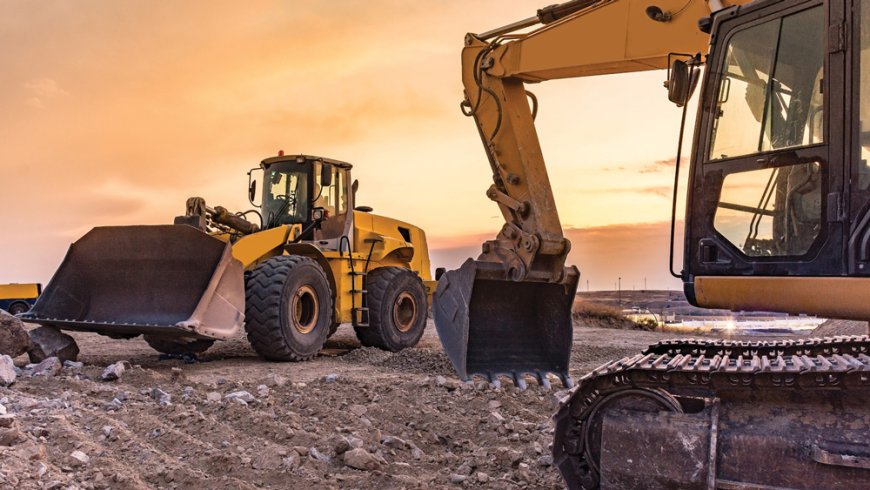CE – a market poised for GROWTH..!
India plans to spend USD 1.4 trillion on infrastructure in the coming five years. The government of India would highly invest in the infrastructure sector, significantly on urban transport infrastructures such as the metro rail network, renewable energy, and highways.

India plans to spend USD 1.4 trillion on infrastructure in the coming five years. The government of India would highly invest in the infrastructure sector, significantly on urban transport infrastructures such as the metro rail network, renewable energy, and highways.
The growing public-private partnerships to implement infrastructure work coupled with wide-scale adoption of the rental business model have induced an increased demand for this equipment over the past few years. Different types of construction machinery are procured to conduct a set of specific tasks and require technical expertise in operating them. The construction machinery is an expensive commodity, thus not every builder, contractor, or construction firm could afford to buy it. Also, there are many construction projects that require construction machinery temporarily. The cost of machinery has increased over the past few years owing to the incorporation of advanced safety technologies, which has triggered the end user’s inclination toward procuring these types of machinery on a rental basis. The rental providers have identified the growth opportunity and have started to upgrade their existing fleet, thereby driving the demand for construction equipment.
According to Grand View Research, the global construction equipment market size was estimated at USD 124.7 billion in 2019 and it is anticipated to expand at a CAGR of 4.3% from 2020 to 2027. Increasing investments by governments across the world for developing public infrastructure has been one of the prime factors driving the market demand for this equipment. Furthermore, the growing population in emerging economies such as India has resulted in increased residential and commercial construction activities. Thus, the market is anticipated to grow steadily over the forecast period.
To save on the cost of machinery and cost incurred behind its maintenance and repairs, small builders, contractors, and construction firms take machinery on a rental basis from the rental service providers. Many companies are entering the construction equipment rental business owing to its high profitability. Construction equipment is very robust machinery with a life span of 7 to 10 years, due to which companies prefer to rent out old machinery for profit. This growing trend of equipment rental business is a significant factor in promoting the market growth.
The demand for construction equipment is high from the residential construction sector owing to speeding urbanization in India. The urbanization triggers not only the demand for residential space but also other related infrastructures such as roads, hospitals, schools, and commercial areas. To cope up with the demand for these public infrastructures, the government spends a significant amount on the construction sector. For instance, according to the India Brand Equity Foundation (IBEF), India plans to spend USD 1.4 trillion on infrastructure in the coming five years. The government of India would highly invest in the infrastructure sector, significantly on urban transport infrastructures such as the metro rail network, renewable energy, and highways.
Speaking about how with the current global and domestic slowdown in the construction sector, do you analyze the CE industry going ahead this year, Vijay Kumar M – Special Invitee to the iCEMA Governing Council and Head – External Affairs and CSR, Tata Hitachi Construction Machinery Co. Ltd., said, “While the COVID-19 Pandemic severely impacted the economy in the first 3-4 months of the current fiscal, demand has been gradually recovering over the last 4-5 months in the Construction Equipment sector. The CE Industry witnessed a 20% YoY volume growth in Q2, FY21 followed by double digit growth in Oct & Nov 2020. However, there exists a ‘low base effect’ here as the Industry had witnessed a >20% decline in the last fiscal (FY19-20) on account of an economic slowdown.”
He further added, “The outlook for the CE Industry in the current fiscal remains positive on the back of robust infrastructure investment by the government. Highway Construction and Awards for the period of Apr-Dec, FY21, have increased by 12% and 110% respectively. In Dec 2020 alone, 1560km of Highways were constructed, up ~60% YoY. Moreover, extension of relaxations under Schedule-H (relief measures to road contractors, concessionaries and developers due to COVID-19) till 30th Jun 2021 by the government has provided good liquidity to contractors and will help maintain the pace of highway construction in the country. It may also be worth mentioning that the announcement of COVID Vaccine in India (to be implemented by Mid Jan 2021) has improved business and consumer confidence/sentiments across sectors and will help in a faster growth revival overall.”
Elaborating on the preparedness for the new emission standards which is expected to be enforced in April this year, he further added, “The CE industry has been very proactive and has been continuously engaging with the government as well as the regulators in jointly working out suitable and appropriate regulations to make the industry safer as well as attain world class standards. The implementation of BS (CEV) IV emission norms for construction equipment vehicles that ply on roads was to have been implemented on 1 October 2020. However, the COVID-19 lockdowns adversely impacted the CE Industry’s road map of meeting the emission norms as factories were closed, Supply chains disrupted and testing facilities not operational.
ICEMA therefore interacted with the government on behalf of the CE Industry to highlight these challenges and the timeline for BS (CEV) IV emission norms has been extended by 6 months (till 1st Apr 2021) by the government. The CE Industry, meanwhile, despite of the challenges faced with respect to COVID-19, has invested in the necessary technology and is fully geared up to meet the new emission norms w.e.f 1st Apr 2021.”
According to Sandeep Mathur, Brand Leader, Case India, said, “The government has been persistently working on stabilizing the infrastructure sector and has announced several projects to boost the infrastructure sector. The Off-Highway Research predicts the market to fall by 27 per cent to 61,225 units in 2020, the availability of the Covid vaccine is expected to push the recovery rate in 2021. Sales may increase 25 per cent to 76,375 units in 2021 and a further 16 per cent to 88,700 units in 2022. The market is forecast to touch 100,300 units in 2023 with a growth of 13 per cent. NHAI has identified 1,500 km of road projects to boost coastal connectivity. This will boost the sector with immense opportunities. Additionally, Finance Minister Nirmala Sitharaman has hinted towards announcement of more projects in the Rs.111 lakh crore National Infrastructure Pipeline. MoRTH has set a target to build 12,000 km of highways for this current financial year and has ensured that it will reduce the build-up of arbitration cases. Around 322 projects with a length of 12,413 Km have been awarded under the Bharatmala Pariyojana till August 2020 by Road ministry. These measures are expected to increase demand of road construction equipment and drive growth for the industry in future.”
The mining and the construction sector was on an upward spiral in FY19, on the back of the growing irrigation, power, cement, and steel sectors compounded with higher investments in construction and infrastructure projects as well as increased government clearances for mining activities. The construction equipment sector along with the entire CV industry experienced de-growth in FY20, as well as the first half of FY21 on account of several headwinds viz. the economic slowdown, liquidity crisis and introduction of increased axle load norms which was further aggravated by the COVID-19 pandemic and the ensuing lockdown, said RT Wasan, Vice President, Product Line, M&HCV, Tata Motors.
“However, the gradual lifting of the lockdown and the economy has boosted the demand for the M&HCV tipper trucks as the construction activities have gradually resumed and new projects in the irrigation, water resources and coal, iron ore and mineral sectors have been announced by the central and the state governments. There has been a noticeable growth in the CV industry volumes month-on-month which has also reflected in the trucks catering to the construction and mining sector. New construction activities for the construction of highways, bridges, tunnels, port connectivity and irrigation as well as mining-specific sectors such as coal and iron ore have had an integral role in the revival of the tipper trucks lately.
With the GDP, in Q1 FY21, bearing the brunt of the pandemic and the nationwide lockdown, contracted by about 23-24%, the CV industry too scraped the bottom of the barrel. From thereon, the GDP was expected to recuperate which was visible in the Q2 of the fiscal which came out at a better than expected contraction of only 7.5%. This steady recovery has been witnessed in the commercial vehicle sector too. While there has been a swift surge in the construction activities in sectors pertaining to irrigation, water resources and minerals, in the post lockdown phase as well as the post monsoon season, the announcement of residential construction projects has also seen a rise on the back of growing realty demand. All of these factors will further continue to fuel the growing demand for the construction equipment vehicle sector in the coming months. Analysts have predicted that a steady rise is expected in the final half of the current fiscal as well as the next fiscal for the commercial vehicle sector.”
S K Jaruhar, Advisor – Support Services, Kobelco Construction Equipment India Pvt. Ltd., “The overall slowdown has been very evident in most markets. However, in India, with the increased thrust from the Central Govt., things have certainly started looking up. There is a growing optimism that things will continue to improve hereon and the economic stability will be regained. Our fight again the pandemic has been largely successful despite some lapses and irresponsible conduct on the part of some.”
Saurabh Kulkarni – Industry Expert – Mobile Automation, B&R Industrial Automation, states, “Global and domestic slowdown has not only affected the construction sector, but also all other sectors. We witness OEMs from various industries gearing up for post slowdown activities and investing wisely in their assets or transformation projects. Similar is the case with OEMs from the CE industry. We expect the sector will pick up slowly but steadily and witness more investments and growth.”
According to Dheeraj Panda, Director, Sales, Marketing and Customer Support, Sany Heavy Industry India Pvt. Ltd, “The construction equipment sector has regained momentum with a moderate growth of sale at the end of this fiscal year 2020. As most of the projects came to a standstill with the imposition of lockdown owing to Covid 19, the CE industry slumped considerably, making it an extremely challenging period to survive. With the government announcing several initiatives like auctioning coal mines on a large scale, Aatmanirbhar Bharat call and restarting the various governmental flagship programs like ‘Smart Cities’, ‘Housing for All’, ‘Make in India’ and ‘Atal Mission’, the CE Industry is gradually attaining the lost glory. The Government also provided relief measures while directing the state government to use Rs. 31,000 crore welfare funds to help laborers in the construction industry. Beating the Covid -19 blues we at Sany India have lodged moderate sale post COVID and we foresee the CE industry to make a comeback with big numbers in the near future.”
Hits: 260











